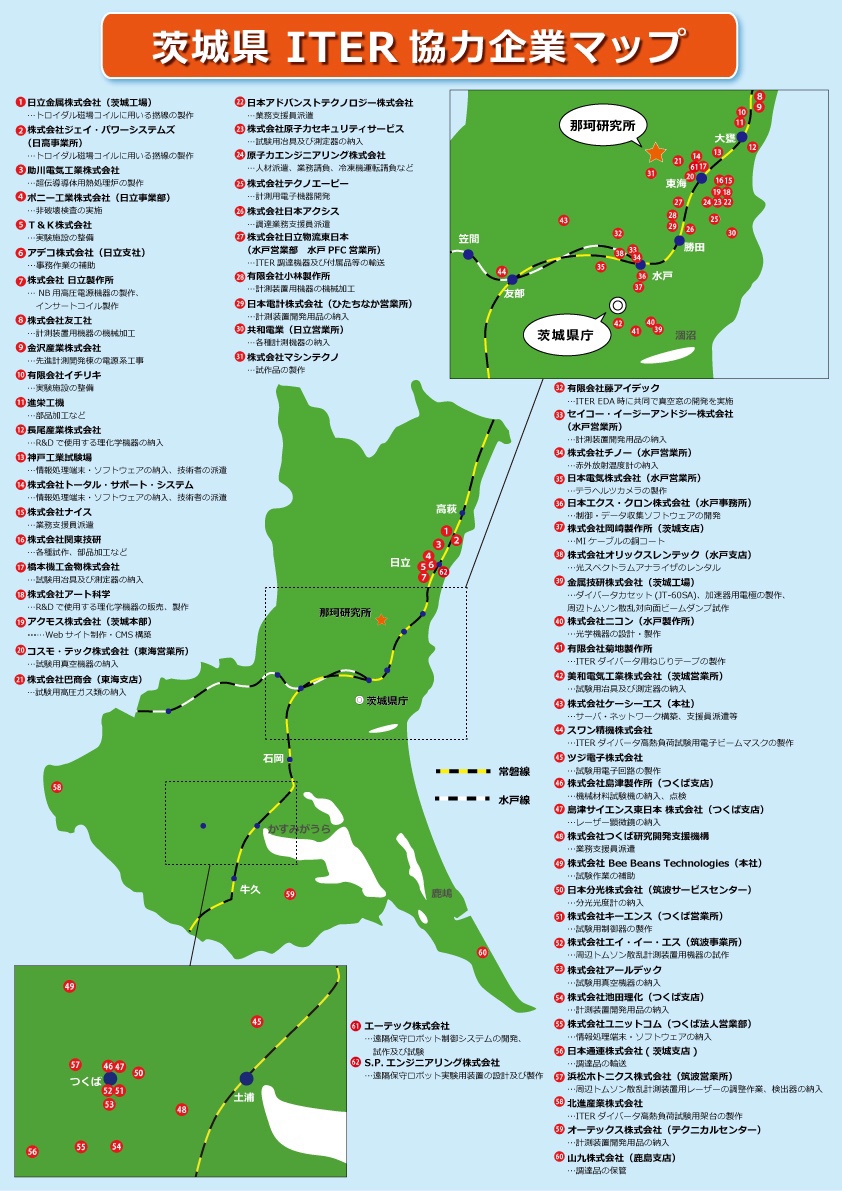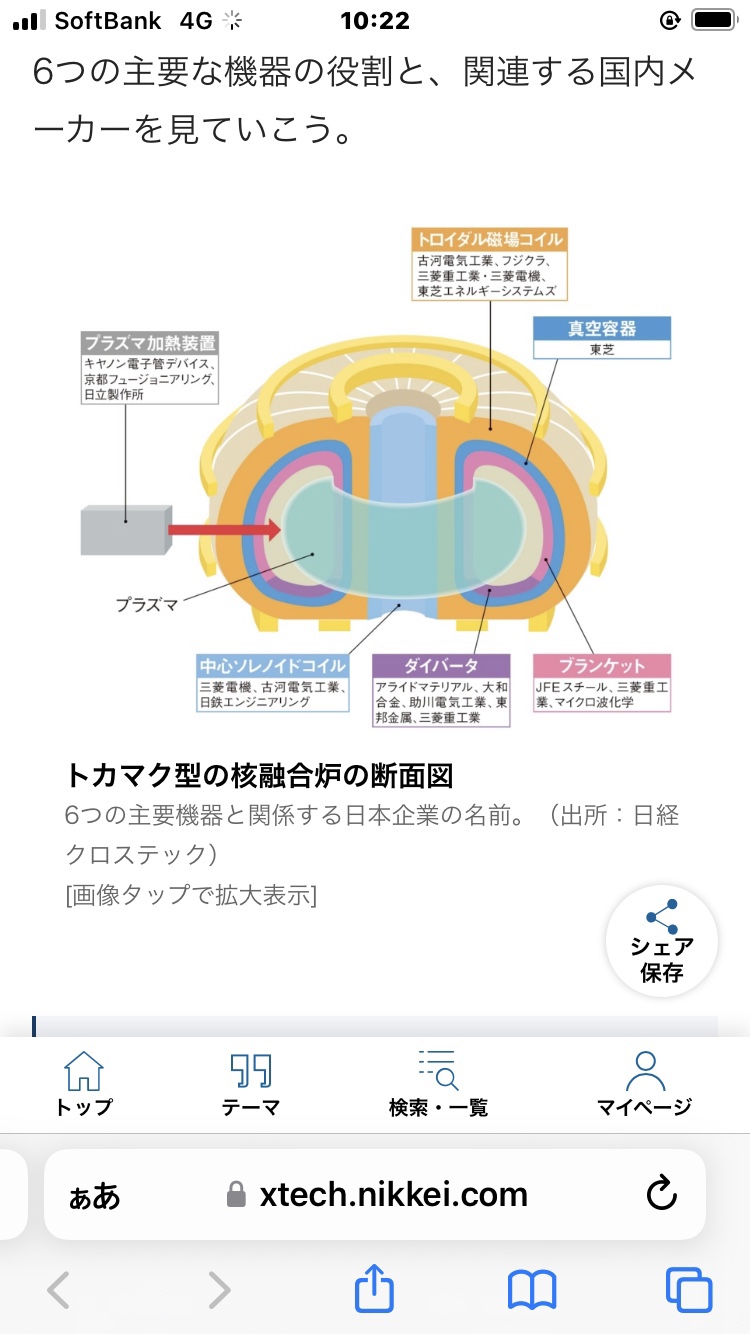

Japan’s Fusion Reactor:日本のITER業界一覧!
liste de l’industrie japonaise ITER !
Liste der japanischen ITER-Industrie!
List of Japan’s ITER Industry!
日本聚變堆:日本ITER產業一覽!
ー6つの主要機器メーカーの日本地図ー
日本メーカーの核融合炉:
その中核となるのが、「核融合反応を起こす核融合炉」だ。
「重水素と三重水素など2つの原子核」を、プラズマ状態でぶつけて融合する。
「その際生じるエネルギーを活用する」のだ。
ー日本メーカーの核融合炉開発ー
核融合炉の基本を確認しながら、日本メーカーの取り組みを見てみる。
「トカマク型」核融合炉:
「トカマク型」と呼ぶ方式の核融合炉を中心に解説する。
フランスの国際熱核融合実験炉(ITER)、日本の量研機構・那珂研究所で稼働の予定。
世界最大級・核融合実験装置「JT-60SA」などが採用している。
「ヘリカル型」核融合炉:
ヘリカル型はトカマク型と同様、「磁場でプラズマを閉じ込める」が、コイルの形状が異なる。
「レーザー方式」核融合炉:
強力なレーザーを燃料に照射して、核融合反応を起こすレーザー方式などがある。
トカマク型の核融合炉の断面:
核融合炉の断面は、次の図のようになっている。炉を構成する機器の内、「6つの主要な機器の役割と、関連する日本メーカー」を見ていこう。1.トロイダル磁場(TF)コイル:
ートロイダル状(円環状)コアに、超電導線材を巻いたコイルー
「電流を流してドーナツ空間に強い磁場」をつくり、高温プラズマを磁場で閉じ込める。
TFコイルだけでは、プラズマが安定しない。
そこで、「プラズマを内周方向へ押し込めるポロイダル磁場(PF)コイル」と一緒に使う。
日本の製作メーカー:
古河電気工業:高温超電導線材
TFコイルを構成する部材関連では、古河電気工業が核融合スタートアップの英トカマクエナジーから、高温超電導線材を受注した。
フジクラ:高温超電導線材
フジクラは、米MIT・核融合炉のコモンウェルス・フュージョンから、高温超電導線材を受注した。
ITERのTFコイル:
三菱重工業・三菱電機と、東芝エネルギーシステムズ(川崎市)がI、TERのTFコイルを製作した。
2.中心ソレノイド(CS)コイル:
ー炉中央部の筒状空間に設置する超電導コイルー
核融合反応を起こすには加熱によって水素などをプラズマ状態にする。
「つまり原子核と電子が分離した状態」にしなければならない。
CSコイルは:
そのプラズマの立ち上げなどを担う機器だ。
コイルに電流を流すとプラズマにも電流が流れ、プラズマを加熱する。
日本の製作メーカー:
三菱電機
三菱電機は、JT60-SAのCSコイルを製作した。古河電気工業
古河電気工業は、 ITER向け超電導・素線を製作。日鉄エンジニアリング
超電導・素線などをより合わせ、「超電導ケーブルを挿入する金属管と溶接する」のだ。
「金属管内への超電導ケーブル引込み・巻取り工程」向けに、
ITER向けに、超電導・導体を製作している。
3.プラズマ加熱装置
ー核融合炉で必要なプラズマ温度は、1億℃以上ー
「超高温にまで加熱し、核融合反応を持続させる」には、2種類の加熱装置が必要だ。
1つは、ジャイロトロン:
電子レンジと同じ原理で、電磁波でプラズマを加熱する装置。
具体的な機器名としては、「高周波を発振する電子管であるジャイロトロン」が挙げられる。
もう1つは、NBI加熱装置:
プラズマに高エネルギーの中性粒子を打ち込んでプラズマを加熱する。
中性粒子入射(NBI)加熱装置だ。
日本の製作メーカー:
キヤノン電子管デバイス
キヤノン電子管デバイスが 、ITER向けのジャイロトロンを手掛けた。京都フュージョニアリング
スタートアップの京都フュージョニアリングも、ジャイロトロンの開発を手掛ける。日立製作所
日立製作所は、ITERのNBI加熱装置を製作している。日経クロステック(xTECH)
https://xtech.nikkei.com/atcl/nxt/column/18/00001/07886/
Réacteur à fusion japonais : liste de l’industrie japonaise ITER !
-Carte du Japon par 6 principaux fabricants d’appareils-
Réacteurs à fusion des constructeurs japonais :
Au cœur se trouve un “réacteur de fusion nucléaire qui provoque une réaction de fusion nucléaire”.
“Deux noyaux atomiques tels que le deutérium et le tritium” sont fusionnés en les frappant à l’état de plasma.
“Profitez de cette énergie.”
– Développement d’un réacteur à fusion par un fabricant japonais –
Jetons un coup d’œil aux efforts des fabricants japonais tout en confirmant les bases des réacteurs à fusion nucléaire.
Réacteur à fusion « type Tokamak » :
L’explication portera sur le réacteur à fusion nucléaire de la méthode dite “de type Tokamak”.
Le réacteur thermonucléaire expérimental international (ITER) en France et l’Institut Naka de QST au Japon devraient être opérationnels.
Le plus grand dispositif expérimental de fusion nucléaire au monde “JT-60SA” est utilisé.
Réacteur de fusion « hélicoïdal » :
Comme le type tokamak, le type hélicoïdal “confine le plasma avec un champ magnétique”, mais la forme de la bobine est différente.
Réacteur de fusion « méthode laser » :
Il existe également une méthode laser qui irradie le combustible avec un laser puissant pour provoquer une réaction de fusion nucléaire.
Coupe transversale d’un réacteur à fusion de type tokamak :
La coupe transversale d’un réacteur à fusion est représentée sur la figure ci-dessous. Jetons un coup d’œil aux “rôles de 6 appareils principaux et des fabricants japonais associés” parmi les appareils qui composent le four. 1. Bobine de champ magnétique toroïdal (TF) :
Bobine avec fil supraconducteur enroulé autour d’un noyau toroïdal (annulaire)
“Un champ magnétique puissant est créé dans l’espace du beignet en faisant passer un courant électrique”, et le plasma à haute température est confiné par le champ magnétique.
Le plasma n’est pas stable avec seulement la bobine TF.
Par conséquent, il est utilisé avec une “bobine de champ magnétique poloidal (PF) qui pousse le plasma vers l’intérieur”.
Fabricants japonais :
Furukawa Electric : Fil supraconducteur haute température
Furukawa Electric Co., Ltd. a reçu une commande de matériaux de fil supraconducteur à haute température de la part de la start-up britannique de fusion nucléaire Tokamak Energy.
Fujikura : fil supraconducteur haute température
Fujikura a reçu une commande de fils supraconducteurs à haute température de Commonwealth Fusion, un réacteur à fusion nucléaire exploité par le MIT aux États-Unis.
Bobine TF d’ITER :
Mitsubishi Heavy Industries/Mitsubishi Electric et Toshiba Energy Systems (Kawasaki City) ont produit des bobines TF pour I et TER.
2. Bobine de solénoïde centrale (CS) :
-Bobine supraconductrice installée dans l’espace cylindrique au centre du réacteur-
Afin d’initier une réaction de fusion nucléaire, l’hydrogène est chauffé à l’état de plasma.
“En d’autres termes, le noyau et les électrons doivent être séparés.”
Les bobines CS sont :
Cet appareil est responsable du démarrage du plasma.
Lorsqu’un courant traverse la bobine, le courant traverse également le plasma, chauffant le plasma.
Fabricants japonais :
Mitsubishi électrique
Mitsubishi Electric a fabriqué la bobine CS pour JT60-SA.
Furukawa électrique
Furukawa Electric fabrique des fils supraconducteurs pour ITER.
Ingénierie de l’acier nippon
Les fils supraconducteurs sont torsadés ensemble et “soudés avec un tube métallique dans lequel un câble supraconducteur est inséré”.
Pour le processus de tréfilage et d’enroulement de câbles supraconducteurs dans des tuyaux métalliques,
Fabrique des supraconducteurs et des conducteurs pour ITER.
3. Dispositif de chauffage au plasma
-La température du plasma requise pour un réacteur à fusion nucléaire est de 100 millions de degrés Celsius ou plus-
Deux types de dispositifs de chauffage sont nécessaires pour “chauffer à des températures ultra-élevées et entretenir la réaction de fusion”.
L’un est le gyrotron :
Un appareil qui chauffe le plasma avec des ondes électromagnétiques utilisant le même principe qu’un four à micro-ondes.
Un nom spécifique de l’appareil est “gyrotron, qui est un tube électronique qui oscille à haute fréquence”.
L’autre est le dispositif de chauffage NBI :
Le plasma est chauffé en y injectant des particules neutres à haute énergie.
Il s’agit d’un appareil de chauffage à injection de particules neutres (NBI).
Fabricants japonais :
appareil à tube électronique canon
Canon Electron Tube Devices a travaillé sur le gyrotron pour ITER.
Kyoto Fusioneering
La startup Kyoto Fusioneering travaille également au développement du gyrotron.
Hitachi
Hitachi construit l’équipement de chauffage NBI pour ITER.
Nikkei CrossTech (xTECH)
Japans Fusionsreaktor: Liste der japanischen ITER-Industrie!
-Karte von Japan von 6 großen Geräteherstellern-
Fusionsreaktoren japanischer Hersteller:
Sein Kern ist ein „Kernfusionsreaktor, der eine Kernfusionsreaktion auslöst“.
“Zwei Atomkerne wie Deuterium und Tritium” werden verschmolzen, indem man sie in einem Plasmazustand trifft.
„Nutzen Sie diese Energie.“
– Fusionsreaktorentwicklung eines japanischen Herstellers –
Werfen wir einen Blick auf die Bemühungen japanischer Hersteller, während wir die Grundlagen von Kernfusionsreaktoren bestätigen.
Fusionsreaktor vom „Tokamak-Typ“:
Die Erklärung konzentriert sich auf den Kernfusionsreaktor des als “Tokamak-Typ” bezeichneten Verfahrens.
Der International Thermonuclear Experimental Reactor (ITER) in Frankreich und das Naka Institute of QST in Japan sollen in Betrieb gehen.
Zum Einsatz kommt das weltweit größte Kernfusions-Experimentalgerät „JT-60SA“.
„Helix“-Fusionsreaktor:
Wie der Tokamak-Typ “schließt der spiralförmige Typ das Plasma mit einem Magnetfeld ein”, aber die Form der Spule ist anders.
Fusionsreaktor „Laserverfahren“:
Es gibt auch ein Laserverfahren, bei dem der Brennstoff mit einem starken Laser bestrahlt wird, um eine Kernfusionsreaktion auszulösen.
Querschnitt eines Fusionsreaktors vom Tokamak-Typ:
Der Querschnitt eines Fusionsreaktors ist in der folgenden Abbildung dargestellt. Werfen wir einen Blick auf die “Rollen von 6 Hauptgeräten und verwandten japanischen Herstellern” unter den Geräten, aus denen der Ofen besteht. 1. Toroidale Magnetfeldspule (TF):
Spule mit supraleitendem Draht, der um einen Ringkern gewickelt ist
“Durch das Hindurchleiten eines elektrischen Stroms wird im Donut-Raum ein starkes Magnetfeld erzeugt”, und das Hochtemperaturplasma wird durch das Magnetfeld eingeschlossen.
Plasma ist nicht stabil nur mit der TF-Spule.
Daher wird es zusammen mit einer “poloidalen Magnetfeldspule (PF) verwendet, die das Plasma nach innen drückt”.
Japanische Hersteller:
Furukawa Electric: Supraleitender Hochtemperaturdraht
Furukawa Electric Co., Ltd. hat vom britischen Kernfusions-Startup Tokamak Energy einen Auftrag für hochtemperatursupraleitende Drahtmaterialien erhalten.
Fujikura: Hochtemperatur-Supraleiterdraht
Fujikura erhielt einen Auftrag für Hochtemperatur-Supraleiterdrähte von Commonwealth Fusion, einem vom MIT in den Vereinigten Staaten betriebenen Kernfusionsreaktor.
TF-Spule von ITER:
Mitsubishi Heavy Industries/Mitsubishi Electric und Toshiba Energy Systems (Kawasaki City) produzierten TF-Spulen für I und TER.
2. Mittlere Magnetspule (CS):
-Supraleitende Spule, installiert im zylindrischen Raum in der Mitte des Reaktors-
Um eine Kernfusionsreaktion auszulösen, wird Wasserstoff in einen Plasmazustand erhitzt.
“Mit anderen Worten, Kern und Elektronen müssen getrennt werden.”
CS-Spulen sind:
Dieses Gerät ist für das Hochfahren des Plasmas verantwortlich.
Wenn ein Strom durch die Spule geleitet wird, fließt der Strom auch durch das Plasma und erwärmt das Plasma.
Japanische Hersteller:
Mitsubishi Electric
Mitsubishi Electric hat die CS-Spule für JT60-SA hergestellt.
Furukawa elektrisch
Furukawa Electric fertigt supraleitende Drähte für ITER.
Nippon Steel Engineering
Supraleitende Drähte werden miteinander verdrillt und “mit einem Metallrohr verschweißt, in das ein supraleitendes Kabel eingeführt wird”.
Für den Prozess des Ziehens und Wickelns von supraleitenden Kabeln in Metallrohre,
Stellt Supraleiter und Leiter für ITER her.
3. Plasmaheizgerät
-Die für einen Kernfusionsreaktor erforderliche Plasmatemperatur beträgt 100 Millionen Grad Celsius oder mehr-
Zwei Arten von Heizgeräten sind erforderlich, um “auf ultrahohe Temperaturen zu erhitzen und die Fusionsreaktion aufrechtzuerhalten”.
Eines ist das Gyrotron:
Ein Gerät, das Plasma mit elektromagnetischen Wellen nach dem gleichen Prinzip wie ein Mikrowellenherd erhitzt.
Ein spezifischer Name des Geräts ist “Gyrotron, eine Elektronenröhre, die mit hohen Frequenzen oszilliert”.
Das andere ist das NBI-Heizgerät:
Das Plasma wird erhitzt, indem hochenergetische neutrale Teilchen hinein injiziert werden.
Es ist ein Heizgerät mit neutraler Partikelinjektion (NBI).
Japanische Hersteller:
Canon Elektronenröhrengerät
Canon Electron Tube Devices arbeitete am Gyrotron für ITER.
Kyoto Fusioneering
Auch das Startup Kyoto Fusioneering arbeitet an der Entwicklung des Gyrotrons.
Hitachi
Hitachi baut die NBI-Heizausrüstung für ITER.
Nikkei Cross Tech (xTECH)